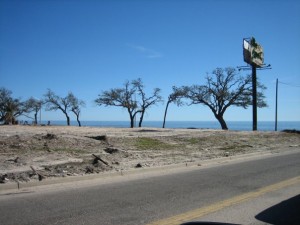
A beachfront Olive Garden in Biloxi was heavily damaged by Hurricane Katrina and cleared away. Only the sign remained along U.S. 90— an area where most homes and business were lost to the Aug. 29, 2005 storm. Photo by Michael Newsom.
On Aug. 29, 2005, I was just beginning my junior year at Harrison Central High School in Gulfport. I had just returned from a meeting in Jackson for one of the school clubs I was in and saw businesses covering their windows in plywood. I remember hearing the newscast saying that Hurricane Katrina would head west of the Coast and thought, “Why is everyone boarding up? It’s not going to be bad here.”
I was wrong.
My entire family is from the Gulf Coast. For every hurricane before that, we always stayed put, and this was no exception. When my parents were young, both stayed on the Coast through Hurricane Camille in 1969 and survived. The thought for most people in the region became, “Well, nothing will be as bad as Camille, so if we made it through that, we’ll be fine.”
They were wrong.
My parents, my brother and I lived just north of Gulfport, so we weren’t directly in harm’s way when it came to a storm surge.
That Sunday night, we packed the necessities and went next door to stay with my uncle and aunt, Raymond and Dena Cuevas, along with a few other family members. The next morning, Katrina made its way inland. Even though we were several miles north of Gulfport, the winds were still furious. On several occasions, the roof sounded like it would come off at any moment.
During part of the 14-hourlong storm, my uncle Raymond was on the phone with his brother-in-law, Dwayne Thomas, while the lines still worked. He lived just a few blocks from the Mississippi Sound in Long Beach, and he stayed. Near the end of that call, he was sitting on top of his refrigerator with his elderly neighbor. Their feet were touching the water that had just begun to recede.
Next to my uncle’s house was a pasture where he had several horses. During the height of the storm, the fence blew open. To prevent losing the horses, my uncle put on coveralls and a bicycle helmet before going outside in the 100-plus-miles-per-hour winds to tie the gate shut with a belt. He said the sheer force of the winds prevented him from taking breaths, and he crawled on the ground toward the next house over for a structure to block the wind before my dad hopped in a car to pick him up and bring him back.
Despite all that, we were all unscathed, except for a little bit of roof damage.
However, my dad’s side of the family wasn’t as lucky.
My grandmother, Marie Steube, and my aunt, Karen Steube, each had a house in Pass Christian along St. Louis Bay. Luckily, they stayed with a relative a few miles north of the water. Although the homes were about eight feet above sea level, they stood no chance against a 27-foot storm surge. A house built in 1971 that once withstood multiple storms was gone. There wasn’t a pile of debris were it once stood – only a concrete slab, the only indicator that people once lived there.
The days after the storm are ones I’ll never forget. As soon as Katrina passed, the sun was shining, beating down on a coast with no electricity. We used a battery-powered portable television to keep up with the news throughout that time. The images of the aftermath were horrifying. No street signs. No landmarks. The entire shoreline looked like a war zone. I still remember waking up every day to the nauseating smell of a gas generator that we used to keep the food safe in our freezer, since grocery stores weren’t open and most weren’t even accessible. We were out of school for a month. Many of my classmates relocated and our class size was drastically reduced because of the storm.
But we were the lucky ones. Coast Electric had our electricity restored eight days after Katrina. Others didn’t even have anything to restore power to, due to immense devastation.
It’s been a long road to recovery in the place where I’ve lived most of my life. Ten years later, the communities of south Mississippi are back and better than ever. But no one from there will ever forget Aug. 29, 2005.